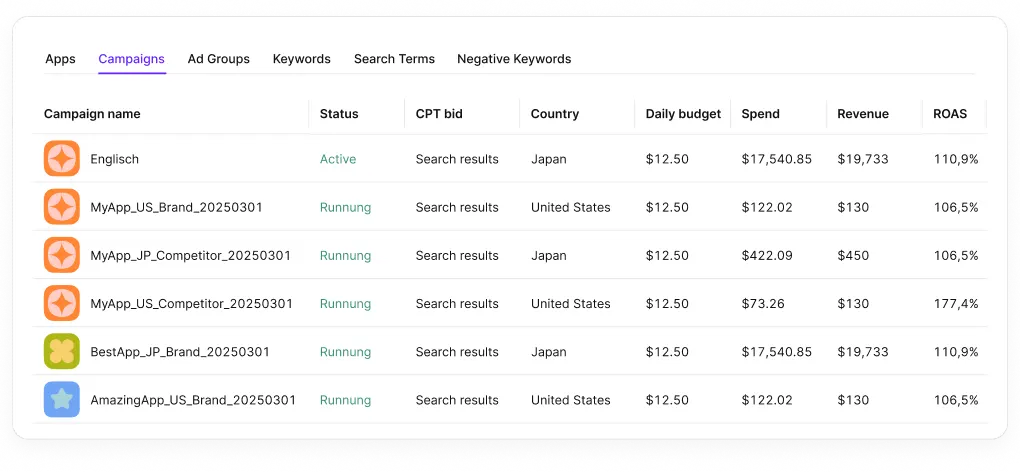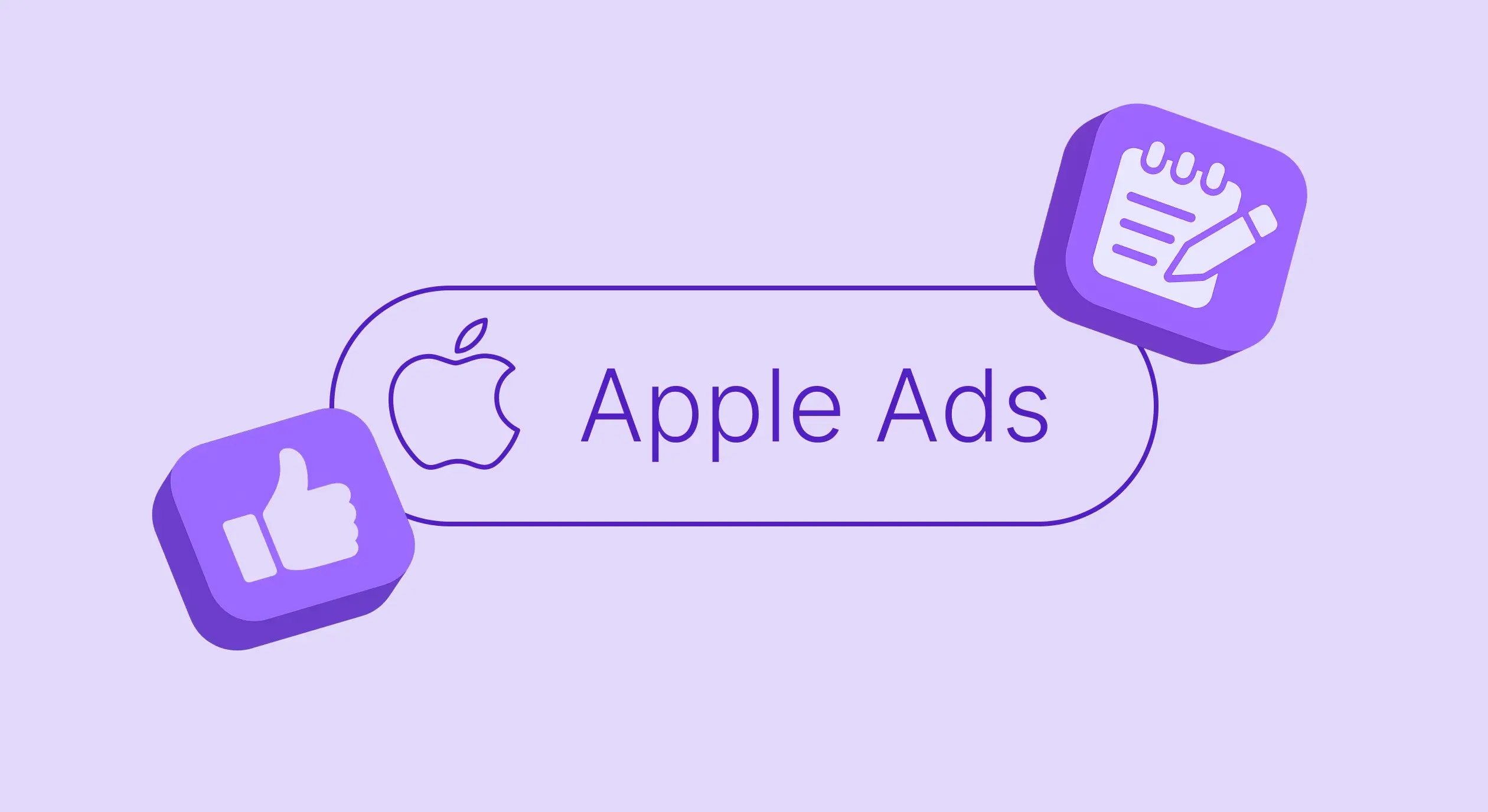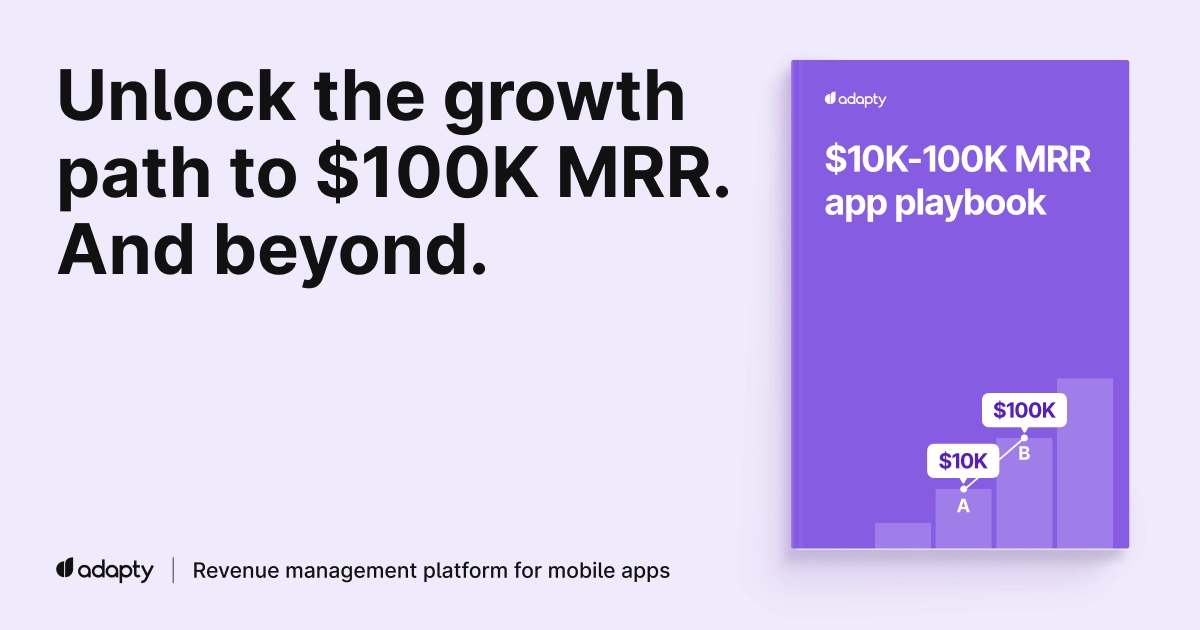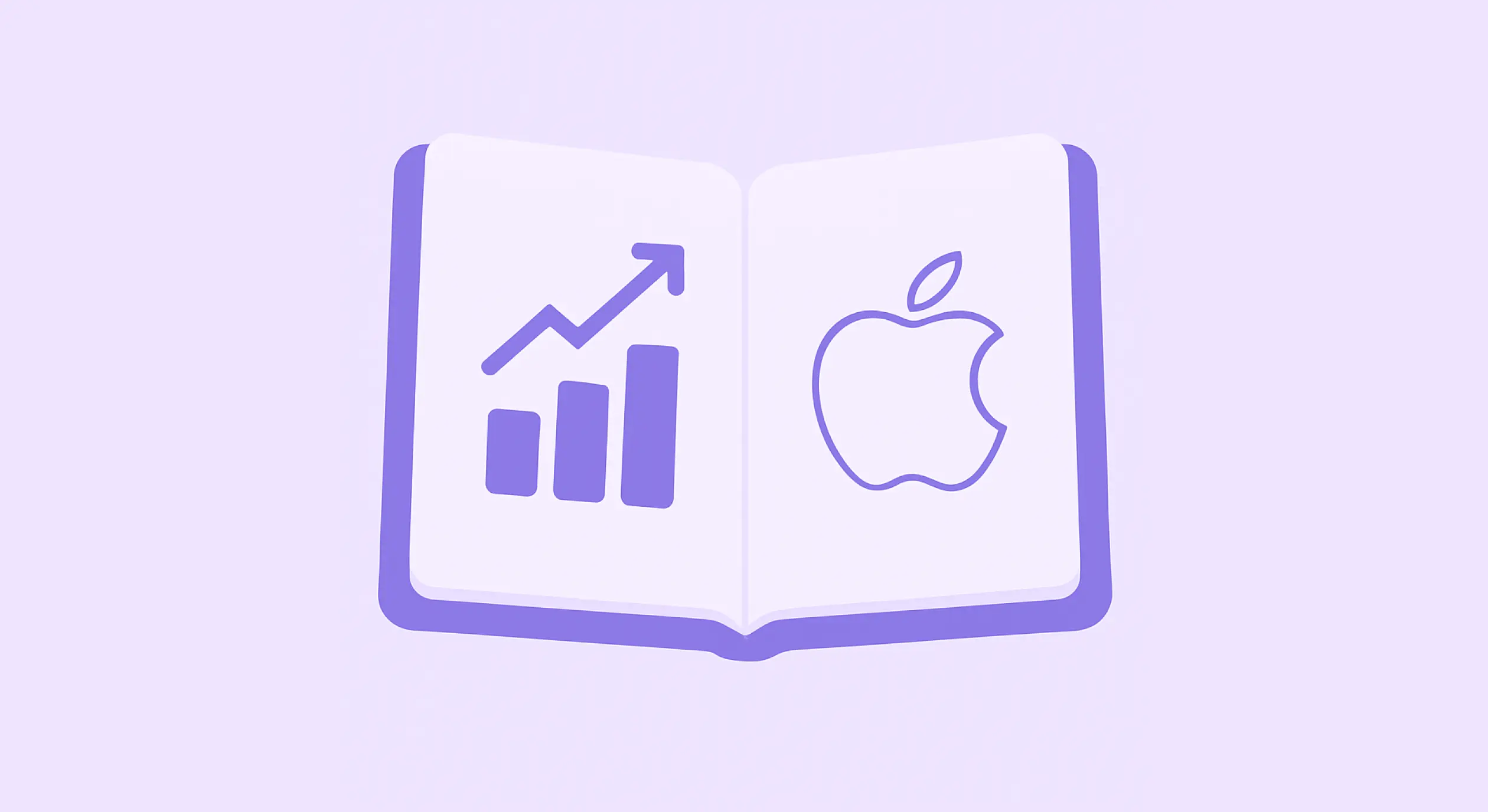TL;DR: Skip Basic mode. Start with exact match. Target 70-90% Share of Voice. Focus on ROAS over everything else. Most campaign structures break at scale.
Apple Ads can either be a goldmine or a money pit. The difference between profitable campaigns and budget-burning disasters comes down to execution fundamentals that most advertisers get wrong.
Here’s what you need to know to run profitable Apple Search Ads campaigns without wasting your budget on common mistakes.
Should I use Basic or Advanced mode for Apple Ads?
Most Apple Ads advice starts with the wrong premise. The conventional wisdom start broad, let Apple learn, gradually optimize sounds reasonable but wastes money and time.
Here’s what actually happens when you follow standard advice: Broad match burns budget on irrelevant traffic, Apple’s “learning phase” means weeks of poor performance, and you end up optimizing campaigns built on shaky foundations.
Always work in Advanced mode. Every profitable campaign I’ve analyzed uses Advanced mode exclusively.
How much should I spend testing Apple Ads keywords?
Your goal isn’t to test everything. It’s to quickly identify which markets and keywords can profitably drive users for your app. This requires strategic focus, not scattered testing.
Geographic strategy based on real data
The biggest mistake I see is treating all international markets the same. They’re not. Each market has distinct competitive dynamics, user behavior patterns, and economic realities.
Always separate the US market. It deserves dedicated campaigns because the competitive landscape and CPC levels make it impossible to optimize alongside other regions.
For international expansion, create strategic tiers:
- Tier 1: UK, Germany, Australia, Canada, Netherlands, Switzerland, Austria, etc.
- Tier 2: Czech Republic, Hungary, Estonia, Latvia, Lithuania, Portugal, etc.
They’re based on iOS market penetration, GDP per capita, and advertising competition levels. Tier 2 markets often deliver better ROAS because competition is lower while purchasing power remains decent.
Don’t automatically dismiss emerging markets, but approach them strategically. Latin America and APAC can work brilliantly for apps with strong local appeal or competitive pricing. However, they require more time and budget to find profitable keywords, so tackle them after you’ve mastered Tier 1 and Tier 2.
Budget allocation principle. Start with maximum two tier campaigns. Concentrate your budget for faster, cleaner learning.
The Exact Match reality check
Here’s an uncomfortable truth most guides won’t tell you: broad match rarely delivers meaningful insights.
Broad match problems are systemic:
- Apple’s interpretation of “broad” often includes wildly irrelevant traffic.
- You get mixed traffic quality that’s impossible to optimize effectively.
Start with exact match campaigns built on solid keyword research instead. This approach works because you’re targeting pre-validated, high-intent search terms from day one.
The research-first methodology:
- Use multiple keyword tools to identify relevant search terms in your category.
- Launch exact match campaigns with thematic keyword groupings.
- Structure as one theme per ad group (habit tracker general, meditation specific, water tracking specific).
- Skip the expensive “discovery” phase entirely.
How do I scale Apple Search Ads campaigns?
Throwing more money at the same campaign structure is the fastest way to tank your ROAS. The campaigns that worked for research will actively hurt you at scale.
Why research structures fail at scale
The campaign structure that worked for discovery creates systematic problems when you’re trying to scale.
Apple doesn’t distribute impressions evenly across keywords within ad groups. Some keywords dominate while others get starved of traffic. You can’t control spend per keyword except through bidding wars. Multiple keywords per ad group create mixed traffic quality that becomes impossible to optimize.
The solution: Evolve to granular structures that give you precise control over budget allocation and performance optimization.
Campaign architecture
Level 1 scaling: Keyword-focused structure
- One campaign per winning geo
- Mix of SKAG (Single Keyword Ad Groups) for high-volume terms
- Multi-keyword ad groups for smaller, thematically related terms
- 100% exact match keywords for traffic quality
Level 2 scaling: Strategic segmentation
- Separate campaigns by theme combined with keyword ARPU potential
- High-ARPU keywords get dedicated campaigns with aggressive bidding strategies
- Lower-ARPU keywords grouped for operational efficiency
- This segmentation matters more than difficulty scores or popularity metrics
Level 3 scaling: Maximum granularity for winners
- Individual campaigns for absolute best-performing keywords
- Custom Product Pages aligned to specific keyword intent
- Dedicated budget allocation based on strategic priority and profit potential
Watch our detailed walkthrough of the Apple Ads campaign structure with OtherWayAround to identify profitable terms before launching campaigns:
The share of voice strategy
Target 70-90% Share of Voice for your best-performing keywords but only while ROAS stays strong. This metric lives in Custom Reports and shows how much available traffic you’re actually grabbing. Most people completely ignore it.
Here’s what actually happens: Most advertisers think their bids are “high enough” when they’re capturing 30% of available impressions. Meanwhile, competitors are scooping up the other 70% of potentially profitable traffic.
Keep pushing your SoV higher until ROAS starts tanking that’s when you stop. Don’t assume high Share of Voice will kill your margins without testing it. You might find that 80% SoV at 3.5x ROAS brings in way more total profit than 30% SoV at 4.2x ROAS.
Bid optimization methodology:
- No delivery → increase bids aggressively until you see traffic.
- Getting spend but low SoV → gradually increase bids to hit 70-90% range.
- High SoV but poor ROAS → question keyword relevance or pause.
Most advertisers obsess over finding the “perfect” CPC. Wrong focus. You want to capture enough share of profitable traffic to make scaling work, even if individual clicks cost more than you’d prefer.
What are the best Apple Ads optimization tactics?
Campaign structure evolution for maximum control
As your campaigns mature, you’ll hit Apple’s delivery limitations even with tight keyword structures. Adding more campaigns won’t solve this. Apple matches your app + keyword combination regardless of how you structure things.
The solution: Fix your App Ads optimization first.
Apple factors your app’s organic relevance before considering your bid. When your app ranks organically for a keyword, your Apple Ads become more competitive. Higher relevance drops your CPCs and improves ROAS.
Advanced keyword strategies:
- Target branded terms where you already rank organically
- Build campaigns around your strongest ASO keywords
- Use Apple Ads data to identify which keywords need ASO work
Apps that dominate Apple Ads have strong organic rankings for their target keywords. Campaign proliferation just creates management overhead without improving delivery.omplexity but guarantees every keyword gets auction participation.
Creative optimization that moves revenue
Custom Product Pages can dramatically improve campaign performance but only when implemented strategically.
The approach that works:
- Start with your top 10 highest-spending, highest-ROAS keywords
- Create CPPs that showcase relevant features prominently in first-view screenshots
- Example: “habit tracker” searches should immediately see habit tracking functionality
- Measure concrete IPM improvements and ROAS impact before expanding
Custom Product Pages work because they increase ad relevance, which Apple rewards with lower CPCs and higher impression priority. The time investment only makes sense for keywords already driving meaningful profitable volume.
What Apple Search Ads metrics should I focus on?
The only metric worth optimizing
ROAS is everything. Not CPC. Not CPI. Not tap-through rates. Only ROAS tells you whether campaigns generate profitable growth.
Attribution setup with Adapty. Setting up proper ROAS tracking is simpler than most people think. If you’re using Adapty for your subscription management, you can connect with one-click Apple OAuth directly through Adapty’s integration. This gives you clean revenue attribution down to the keyword level without complex MMP setups.

For apps not using Adapty for subscription management, you can still install the Adapty SDK in observer mode to get clean Apple Ads attribution without changing your existing payment setup. This gives you the same seamless ROAS tracking without migrating your entire subscription system.
How should I set my Apple Ads bids?
Skip CPA goals for most campaigns. They’re another algorithmic black box that limits control during crucial optimization phases. Manual bidding provides the precision needed for profitable scaling.
Effective manual bidding approach:
- Start conservative based on realistic CPA targets
- Use Share of Voice data to guide bid increases, not daily performance fluctuations
- Bid more aggressively for higher-ARPU keyword segments
- Conduct regular bid reviews based on ROAS trends, not emotional reactions to daily spending
CPA goals make sense only for broad match or Search Match campaigns where you want algorithmic efficiency over granular control.
What Apple Ads mistakes should I avoid?
Research phase killers
- Budget dispersion. You spread $500 across five countries instead of testing one market properly. Result: weak signals everywhere, clear winners nowhere.
- Premature optimization. Three days of data and you’re already reshuffling campaigns. You need weeks, not days, to see meaningful patterns.
- Vanity metric obsession. Your CTR looks amazing but revenue is flat. Clicks don’t pay the bills.
Scaling phase failures
- Over-segmentation. You’ve got 47 campaigns that each need daily attention. The time you spend managing them could be better spent finding new profitable keywords.
- Bid ceiling mentality. “I never bid above $2 CPC” sounds smart until you realize competitors are capturing all the $3 CPC traffic that converts at 5x ROAS.
- Attribution blindness. That keyword looks expensive until you realize it drives 40% more lifetime value than your “cheap” keywords.
Strategic blunders
- Generic advice following. What works for a meditation app won’t work for a productivity tool. Cookie-cutter strategies create cookie-cutter results.
- Platform abandonment. You gave Apple Ads two weeks, called it broken, then watched competitors dominate your keywords for months.
- Short-term thinking. Apple Ads isn’t Facebook. Expecting day-one profitability is like expecting a sourdough starter to work on Tuesday.
The bottom line
Apple Ads profitability requires disciplined execution of basic fundamentals combined with systematic testing.
Advanced mode exclusively, research-driven exact match campaigns, comprehensive ROAS attribution, and relentless optimization based on Share of Voice and profitability metrics.
Research systematically to identify winners, scale strategically while maintaining performance quality, and optimize continuously based on revenue data rather than vanity metrics.
Most advertisers will struggle with this approach because it requires patience, analytical discipline, and genuine commitment to data-driven decision making. The ones who master these principles will have massive competitive advantages in increasingly competitive auctions.
Want to revisit step-by-step setup fundamentals? Visit our Apple Ads beginner’s guide. Looking to unlock deeper performance insights, keyword segmentation, and ROAS-focused optimization? Explore How to analyze and optimize Apple Ads next.




